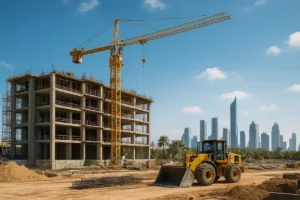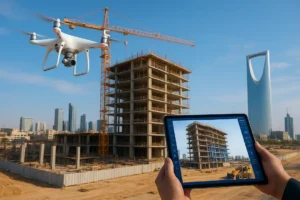Why Design-Build Delivery is a Smart Move for Construction in Saudi Arabia
In today’s fast-moving market, the construction sector in Saudi Arabia is evolving rapidly. With major infrastructure, residential and commercial developments underway, many project owners are asking: Why choose design-build delivery for construction in Saudi Arabia? In this article, we explore what design-build delivery means, how it works, and specifically why it makes smart sense in Saudi Arabia’s construction environment. From cost savings and speed to single-point accountability, we’ll cover the key reasons this method is gaining ground in the Kingdom.
What is Design-Build Delivery in Construction?
Design-build delivery is a project delivery method in which a single entity takes responsibility for both design and construction services under one contract.
In contrast, traditional methods like design-bid-build separate the design phase (by an architect/engineer) and the construction phase (by contractors bidding after design completion).
Key Features
-
One contract for design + construction
-
Early involvement of the builder in design decisions
-
Overlap of design and construction phases (where feasible)
-
A single point of responsibility for the project owner
Why this matters for construction in Saudi Arabia
In the context of construction in Saudi Arabia, where large-scale and complex infrastructure and real-estate developments are under way (driven by Saudi Vision 2030), speed, coordination and risk management are critical. The design-build delivery model offers significant advantages in this setting.
The Construction Market in Saudi Arabia: A Quick Overview
To understand why design-build delivery is a smart choice, it helps to look at the construction market in Saudi Arabia:
-
The construction sector in Saudi Arabia is estimated at USD 70.33 billion in 2024 and projected to reach USD 91.36 billion by 2029.
-
Infrastructure workloads are expected to increase (93% of respondents anticipate more infrastructure work).
-
The legal, regulatory and financing environment in Saudi Arabia for construction is evolving, with public development companies and large-scale projects gaining prominence.
-
At the same time, challenges include sustainability goals, digital adoption (such as BIM) and efficient project delivery.
Given this backdrop, efficiency, speed and coordination are crucial in construction in Saudi Arabia. That makes the design-build delivery method especially relevant.
Why Design-Build Delivery is the Smart Choice for Construction in Saudi Arabia
Here are the main reasons design-build delivery stands out for construction in Saudi Arabia:
1. Faster Delivery & Shorter Schedule
Because design and construction activities can overlap and the builder is involved early, design-build tends to reduce overall project time.
For construction in Saudi Arabia — where project timelines are tight and many developments align with milestones (e.g., Vision 2030 targets) — faster delivery means major advantage.
2. Cost Control & Predictability
With one team responsible from design to construction, owners get better insight into costs earlier and fewer change orders.
In fast-growing construction markets like Saudi Arabia, cost overruns are common. A design-build delivery reduces this risk.
3. Single Point of Accountability
Under design-build delivery the owner deals with a single contract entity. That simplifies communication, decision-making and reduces adversarial relationships.
For construction in Saudi Arabia, where regulatory and stakeholder environments are complex, this clarity is a benefit.
4. Enhanced Collaboration & Innovation
Early collaboration among designers, builders and subcontractors allows for more innovative solutions, value engineering and constructability reviews.
In Saudi Arabia’s construction market, which is embracing digital tools (such as BIM) and sustainability, these collaborative benefits align well.
5. Alignment with Large-Scale Projects & Complex Deliveries
Many of the construction projects in Saudi Arabia are mega-projects, infrastructure heavy, with ambitious design and schedules. The design-build delivery method is particularly suited to such complexity because it allows the builder’s practical input earlier.
6. Reduced Risk for Owners
By handing over design and construction risk to the design-builder, owners are insulated from many of the coordination, design-error and schedule risks typical in design-bid-build.
For construction in Saudi Arabia — where external factors (weather, logistics, labor market) may impose additional risks — this is meaningful.
How Design-Build Delivery Works: Step-by-Step in Saudi Arabia’s Construction Context
Below is a simplified breakdown of the design-build delivery process tailored to construction in Saudi Arabia:
Step 1: Project definition & feasibility
Define the scope, budget and timeline. For a construction project in Saudi Arabia this may include local regulatory, licensing, and sustainability requirements.
Step 2: Selecting the design-builder
The owner issues an RFP (Request for Proposal) and selects a design-build team based on qualifications, approach and budget.
Step 3: Collaborative design phase
Design and construction teams work together early. The builder offers input on constructability, materials, schedule. For construction in Saudi Arabia, compatibility with local codes and supply-chain matters are key.
Step 4: Construction begins while design finalises
Because design is ongoing while some construction may start, the project saves time. This can be especially effective when local approvals and planning in Saudi Arabia are aligned.
Step 5: Construction execution & commissioning
The design-builder leads construction, monitors quality, cost and schedule. For construction in Saudi Arabia this phase needs to align with local labour, logistics and regulatory constraints.
Step 6: Handover and operations
Project is completed, handed over, and any defects or warranties are handled by the design-builder. For construction in Saudi Arabia, the transition to operations needs local stakeholder satisfaction and compliance.
Conclusion
For construction in Saudi Arabia, adopting design-build delivery stands out as a smart choice. From faster project timelines, better cost predictability and simplified contract structure to better coordination in the Kingdom’s ambitious construction market, the benefits are clear. While every project has its unique context, the design-build method aligns strongly with the demands, scale and pace of construction in Saudi Arabia.
If you’re involved in construction in Saudi Arabia — whether as owner, developer, contractor or consultant — exploring design-build delivery can give you a competitive edge and help deliver more successful outcomes.



